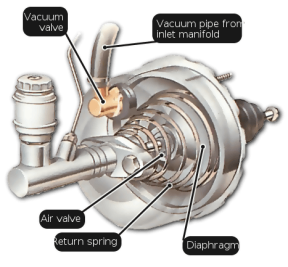Урок "Breaking sysem"
Breaking system
Read and translate the text.
Modern cars have brakes on all four wheels, operated by a hydraulic system. The brakes may be disc type or drum type. The front brakes play a greater part in stopping the car than the rear ones, because braking throws the car weight forward on to the front wheels.
Many cars therefore have disc brakes, which are generally more efficient, at the front and drum brakes at the rear. All-disc braking systems are used on some expensive or high-performance cars, and all-drum systems on some older or smaller cars.
Brake hydraulics
 A hydraulic brake circuit has fluid-filled master and slave cylinders connected by pipes.
A hydraulic brake circuit has fluid-filled master and slave cylinders connected by pipes.
Piston Spring, Fluid Slave, cylinder Brake pedal Master, cylinder Fluid reservoir.
Master and slave cylinders
The master cylinder transmits hydraulic pressure to the slave cylinder when the pedal is pressed.
When you push the brake pedal it depresses a piston in the master cylinder, forcing fluid along the pipe. The fluid travels to slave cylinders at each wheel and fills them, forcing pistons out to apply the brakes.
Fluid pressure distributes itself evenly around the system.
The combined surface 'pushing' area of all the slave pistons is much greater than that of the piston in the master cylinder.
Consequently, the master piston has to travel several inches to move the slave pistons the fraction of an inch it takes to apply the brakes. This arrangement allows great force to be exerted by the brakes, in the same way that a long-handled lever can easily lift a heavy object a short distance.
Most modern cars are fitted with twin hydraulic circuits, with two master cylinders in tandem, in case one should fail.
Sometimes one circuit works the front brakes and one the rear brakes; or each circuit works both front brakes and one of the rear brakes; or one circuit works all four brakes and the other the front ones only.
Under heavy braking, so much weight may come off the rear wheels that they lock, possibly causing a dangerous skid.
For this reason, the rear brakes are deliberately made less powerful than the front. Most cars now also have a load-sensitive pressure-limiting valve. It closes when heavy braking raises hydraulic pressure to a level that might cause the rear brakes to lock and prevents any further movement of fluid to them.
Advanced cars may even have complex anti-lock systems that sense in various ways how the car is decelerating and whether any wheels are locking.
Such systems apply and release the brakes in rapid succession to stop them locking.
Power assisted brakes. Many cars also have power assistance to reduce the effort needed to apply the brakes. Usually the source of power is the pressure difference between the partial vacuum in the inlet manifold and the outside air.
The servo unit that provides the assistance has a pipe connection to the inlet manifold. (Vacuum valve, Vacuum pipe from inlet manifold, Air valve Return spring Diaphragm).
A direct-acting servo is fitted between the brake pedal and the master cylinder. The pedal can work the master cylinder directly if the servo fails or if the engine is not running.
The brake pedal pushes a rod that in turn pushes the master-cylinder piston. But the brake pedal also works on a set of air valves, and there is a large rubber diaphragm connected to the master-cylinder piston.
When the brakes are off, both sides of the diaphragm are exposed to the vacuum from the manifold. Pressing the brake pedal closes the valve linking the rear side of the diaphragm to the manifold and opens a valve that lets in air from outside. The higher pressure of the outside air forces the diaphragm forward to push on the master-cylinder piston, and thereby assists the braking effort.
If the pedal is then held, and pressed no further, the air valve admits no more air from outside, so the pressure on the brakes remains the same.
When the pedal is released, the space behind the diaphragm is reopened to the manifold, so the pressure drops and the diaphragm falls back. If the vacuum fails because the engine stops, for example the brakes still work because there is a normal mechanical link between the pedal and the master cylinder. But much more force must be exerted on the brake pedal to apply them.
Vocabulary
|
front brakes rear weight fluid-filled master slave cylinders apply surface fraction exert lever fail skid deliberately load-sensitive pressure-limiting valve prevent decelerating rapid succession power assistance inlet manifold expose release |
гальма передні гальма задній вага головний циліндр допоміжні циліндри застосовувати поверхня фракція, частка наносити важіль невдача занос навмисно чутливий до навантаження обмежувальний клапан запобігти гальмування швидка послідовність допомога в енергетиці впускний колектор піддавати випуск |
Exercise 1
Translate the sentences into Ukrainian. Make them interrogative and negative.
- The front brakes play a greater part in stopping the car than the rear ones.
- The master cylinder transmits hydraulic pressure to the slave cylinder.
- The fluid travels to slave cylinders at each wheel and fills them, forcing pistons out to apply the brakes.
- The higher pressure of the outside air forces the diaphragm forward.
- The rear brakes are deliberately made less powerful than the front.
- Such systems apply and release the brakes in rapid succession to stop them locking.
Exercise 2
Translate the sentences into English using Present Simple Active or Passive tenses [see Appendix].
- Рідина рухається до циліндрів та заповнює їх.
- Педаль гальма натискає стрижень, який в свою чергу штовхає поршень магістрального циліндра.
- Натискання педалі гальма закриває клапан, що з'єднує задню частину діафрагми з колектором.
- Більшість сучасних автомобілів оснащуються подвійними гідравлічними (системами)ланцюгами, з двома головними циліндрами.
- Системи гальмування на 4 диска використовуються на деяких дорогих або високопродуктивних автомобілях.
- Барабанні системи використовуються на деяких старих або малолітражних моделях автомобілів.
Exercise 3
Match the sentences with the words from the box.
|
Dangerous, wheels, pipes, master-cylinder, rod, pedal, rear, twin hydraulic circuits |
- Modern cars have brakes on all four … , operated by a hydraulic system.
- The brake pedal pushes a …that in turn pushes the master-cylinder piston.
- A hydraulic brake circuit has fluid-filled master and slave cylinders connected by … .
- The higher pressure of the outside air forces the diaphragm forward to push on the … piston.
- Most modern cars are fitted with … , with two master cylinders in tandem.
- The brake … also works on a set of air valves.
- The front brakes play a greater part in stopping the car than the … ones.
- Under heavy braking, so much weight may come off the rear wheels that they lock, possibly causing a … skid.
Exercise 4
Make up a report on the topic “Breaking system in a vehicle”.


про публікацію авторської розробки
Додати розробку
